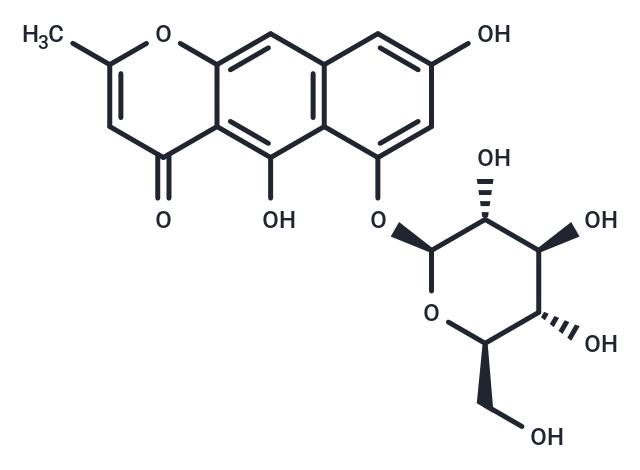Shopping Cart
Remove All Your shopping cart is currently empty
Your shopping cart is currently empty
Cassiaside is a naphthyl ketone glycoside that inhibits BACE1 (IC50= 4.45 μM; Ki=9.85 μM).Cassiaside exhibits significant hepatoprotective effects against galactosamine injury and has potential anti-Alzheimer's disease (AD) activity.

| Pack Size | Price | USA Warehouse | Global Warehouse | Quantity |
|---|---|---|---|---|
| 1 mg | $84 | - | In Stock | |
| 5 mg | $213 | - | In Stock | |
| 10 mg | $369 | - | In Stock | |
| 25 mg | $615 | - | In Stock | |
| 50 mg | Preferential | - | In Stock |
| Description | Cassiaside is a naphthyl ketone glycoside that inhibits BACE1 (IC50= 4.45 μM; Ki=9.85 μM).Cassiaside exhibits significant hepatoprotective effects against galactosamine injury and has potential anti-Alzheimer's disease (AD) activity. |
| Targets&IC50 | BACE1:9.85 μM(Ki), BACE1:4.45 μM |
| Molecular Weight | 420.37 |
| Formula | C20H20O10 |
| Cas No. | 13709-03-0 |
| Smiles | O(C=1C2=C(C=C3C(=C2O)C(=O)C=C(C)O3)C=C(O)C1)[C@@H]4O[C@H](CO)[C@@H](O)[C@H](O)[C@H]4O |
| Relative Density. | 1.660 g/cm3 (Predicted) |
| Storage | store at low temperature,keep away from direct sunlight | Powder: -20°C for 3 years | In solvent: -80°C for 1 year | Shipping with blue ice/Shipping at ambient temperature. | |||||||||||||||||||||||||
| Solubility Information | DMSO: 20 mg/mL (47.58 mM), Sonication is recommended. | |||||||||||||||||||||||||
| In Vivo Formulation | 10% DMSO+40% PEG300+5% Tween 80+45% Saline: 2 mg/mL (4.76 mM), Sonication is recommended. Please add the solvents sequentially, clarifying the solution as much as possible before adding the next one. Dissolve by heating and/or sonication if necessary. Working solution is recommended to be prepared and used immediately. The formulation provided above is for reference purposes only. In vivo formulations may vary and should be modified based on specific experimental conditions. | |||||||||||||||||||||||||
Solution Preparation Table | ||||||||||||||||||||||||||
DMSO
| ||||||||||||||||||||||||||
| Size | Quantity | Unit Price | Amount | Operation |
|---|

Copyright © 2015-2025 TargetMol Chemicals Inc. All Rights Reserved.